Assessing COVID-19's Impact on Healthcare Workers in Kuwait: A Report
VerifiedAdded on 2022/12/27
|17
|5288
|25
Report
AI Summary
This report presents a pilot study assessing the impact of the COVID-19 pandemic on the quality of life of healthcare workers in Kuwait. The study investigates various challenges faced by these workers, including long working hours, increased patient loads, social isolation, and the fear of contracting the virus, all while maintaining healthcare services for both COVID-19 and non-COVID-19 patients. The research utilizes the WHOQOL-BREF questionnaire to evaluate the physical health, mental health, social relationships, and environmental aspects of the healthcare workers' lives. The study aims to provide baseline information and insights for policymakers to develop strategies that enhance the quality of life of healthcare workers, protect them from burnout, and improve their overall wellbeing. The findings are based on a sample of 74 healthcare workers, examining their demographics, global evaluations of health, and satisfaction levels, with data analysis performed using SPSS version 26. The study highlights the importance of understanding the correlation between quality of life and wellbeing to better address the needs of healthcare professionals during and after the pandemic.
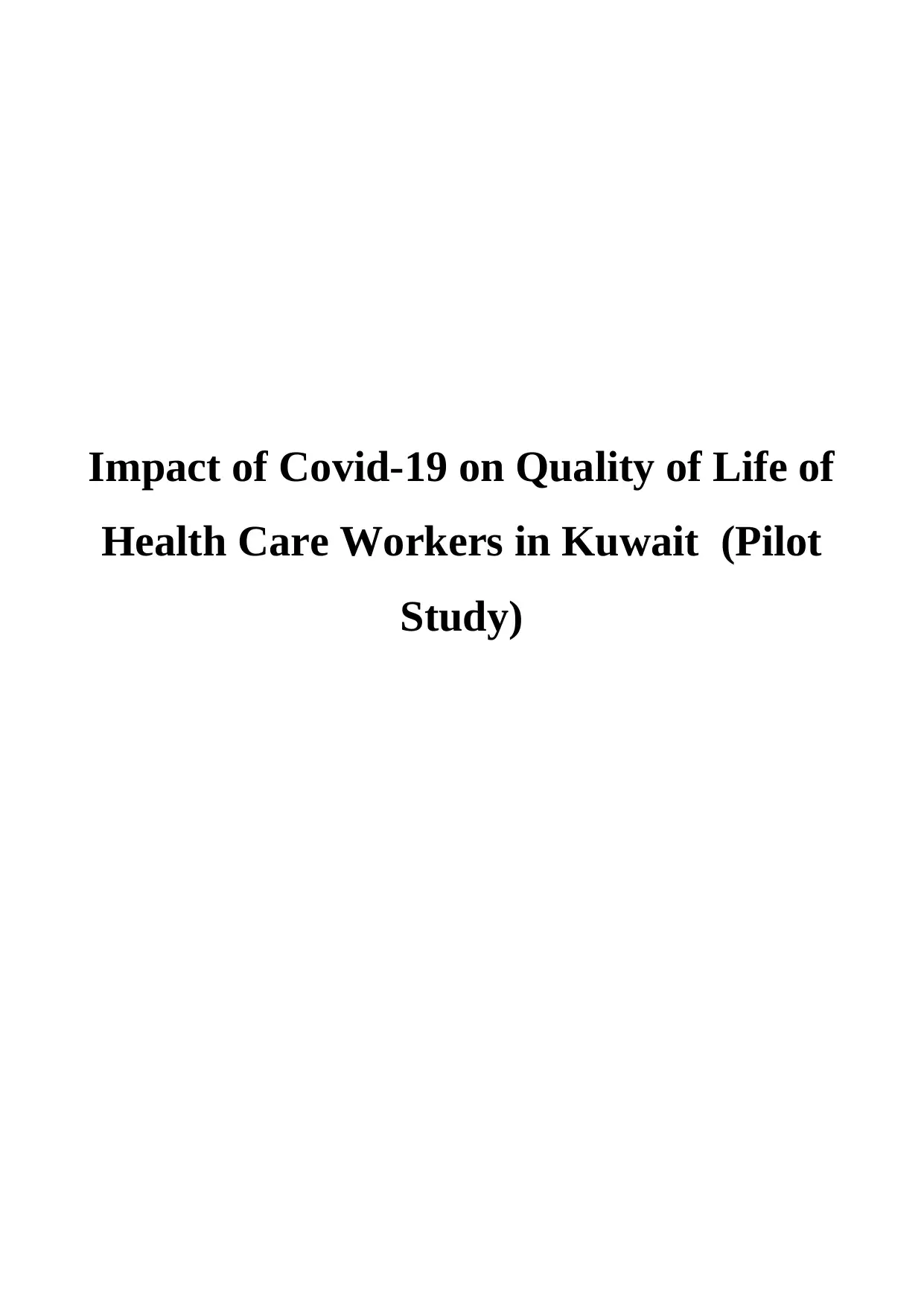
Impact of Covid-19 on Quality of Life of
Health Care Workers in Kuwait (Pilot
Study)
Health Care Workers in Kuwait (Pilot
Study)
Paraphrase This Document
Need a fresh take? Get an instant paraphrase of this document with our AI Paraphraser
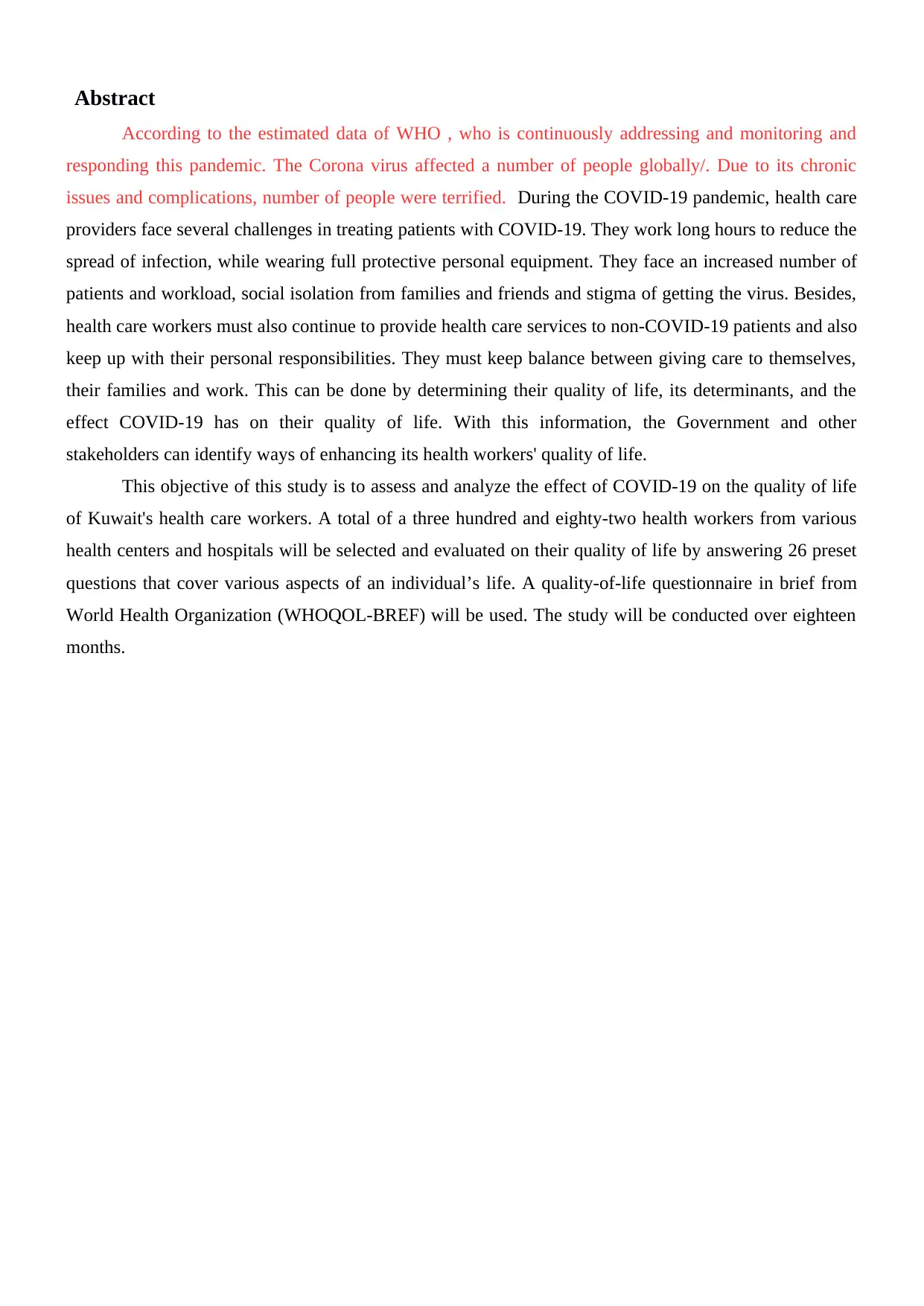
Abstract
According to the estimated data of WHO , who is continuously addressing and monitoring and
responding this pandemic. The Corona virus affected a number of people globally/. Due to its chronic
issues and complications, number of people were terrified. During the COVID-19 pandemic, health care
providers face several challenges in treating patients with COVID-19. They work long hours to reduce the
spread of infection, while wearing full protective personal equipment. They face an increased number of
patients and workload, social isolation from families and friends and stigma of getting the virus. Besides,
health care workers must also continue to provide health care services to non-COVID-19 patients and also
keep up with their personal responsibilities. They must keep balance between giving care to themselves,
their families and work. This can be done by determining their quality of life, its determinants, and the
effect COVID-19 has on their quality of life. With this information, the Government and other
stakeholders can identify ways of enhancing its health workers' quality of life.
This objective of this study is to assess and analyze the effect of COVID-19 on the quality of life
of Kuwait's health care workers. A total of a three hundred and eighty-two health workers from various
health centers and hospitals will be selected and evaluated on their quality of life by answering 26 preset
questions that cover various aspects of an individual’s life. A quality-of-life questionnaire in brief from
World Health Organization (WHOQOL-BREF) will be used. The study will be conducted over eighteen
months.
According to the estimated data of WHO , who is continuously addressing and monitoring and
responding this pandemic. The Corona virus affected a number of people globally/. Due to its chronic
issues and complications, number of people were terrified. During the COVID-19 pandemic, health care
providers face several challenges in treating patients with COVID-19. They work long hours to reduce the
spread of infection, while wearing full protective personal equipment. They face an increased number of
patients and workload, social isolation from families and friends and stigma of getting the virus. Besides,
health care workers must also continue to provide health care services to non-COVID-19 patients and also
keep up with their personal responsibilities. They must keep balance between giving care to themselves,
their families and work. This can be done by determining their quality of life, its determinants, and the
effect COVID-19 has on their quality of life. With this information, the Government and other
stakeholders can identify ways of enhancing its health workers' quality of life.
This objective of this study is to assess and analyze the effect of COVID-19 on the quality of life
of Kuwait's health care workers. A total of a three hundred and eighty-two health workers from various
health centers and hospitals will be selected and evaluated on their quality of life by answering 26 preset
questions that cover various aspects of an individual’s life. A quality-of-life questionnaire in brief from
World Health Organization (WHOQOL-BREF) will be used. The study will be conducted over eighteen
months.
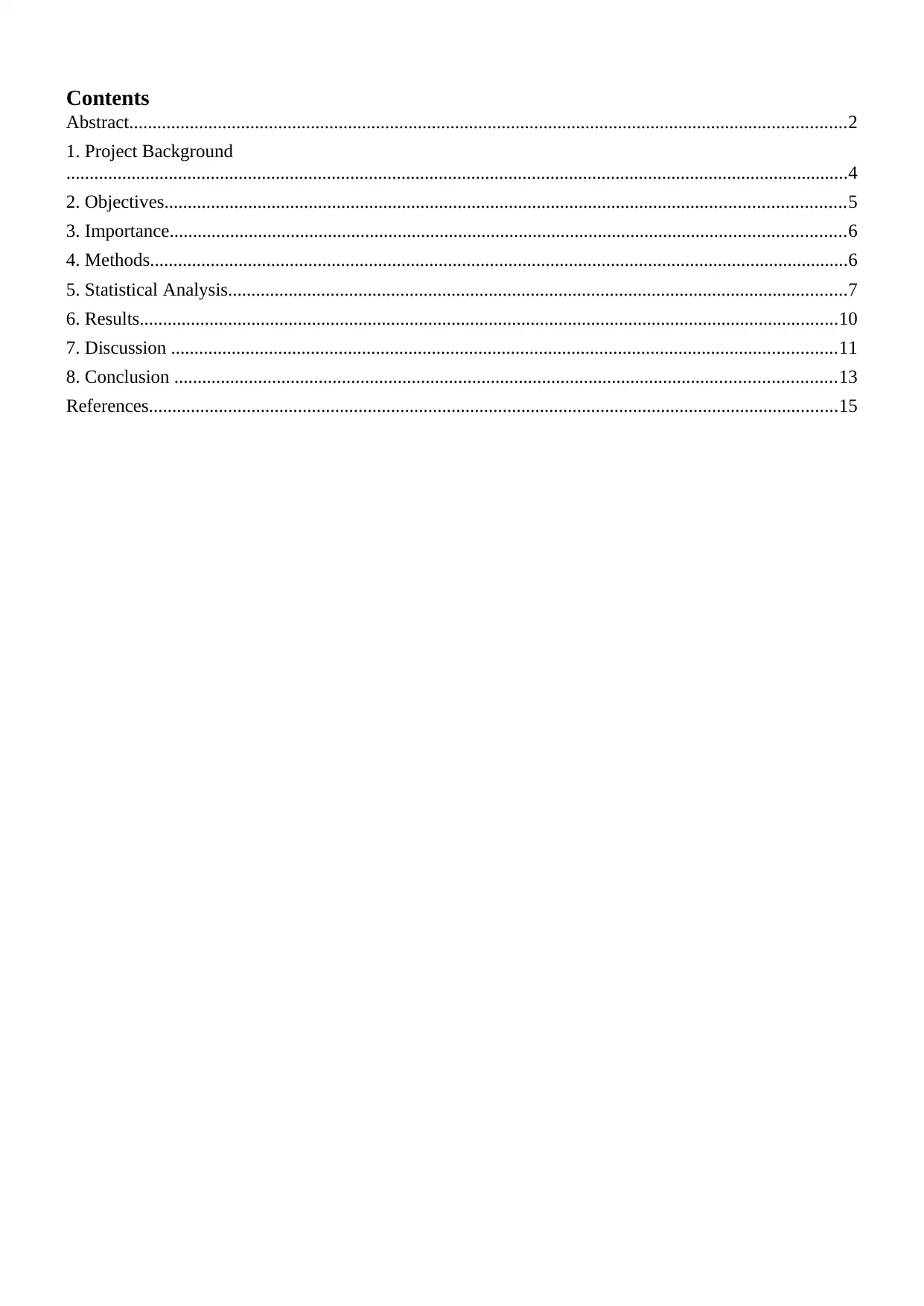
Contents
Abstract..........................................................................................................................................................2
1. Project Background
........................................................................................................................................................................4
2. Objectives..................................................................................................................................................5
3. Importance.................................................................................................................................................6
4. Methods......................................................................................................................................................6
5. Statistical Analysis.....................................................................................................................................7
6. Results......................................................................................................................................................10
7. Discussion ...............................................................................................................................................11
8. Conclusion ..............................................................................................................................................13
References....................................................................................................................................................15
Abstract..........................................................................................................................................................2
1. Project Background
........................................................................................................................................................................4
2. Objectives..................................................................................................................................................5
3. Importance.................................................................................................................................................6
4. Methods......................................................................................................................................................6
5. Statistical Analysis.....................................................................................................................................7
6. Results......................................................................................................................................................10
7. Discussion ...............................................................................................................................................11
8. Conclusion ..............................................................................................................................................13
References....................................................................................................................................................15
⊘ This is a preview!⊘
Do you want full access?
Subscribe today to unlock all pages.

Trusted by 1+ million students worldwide
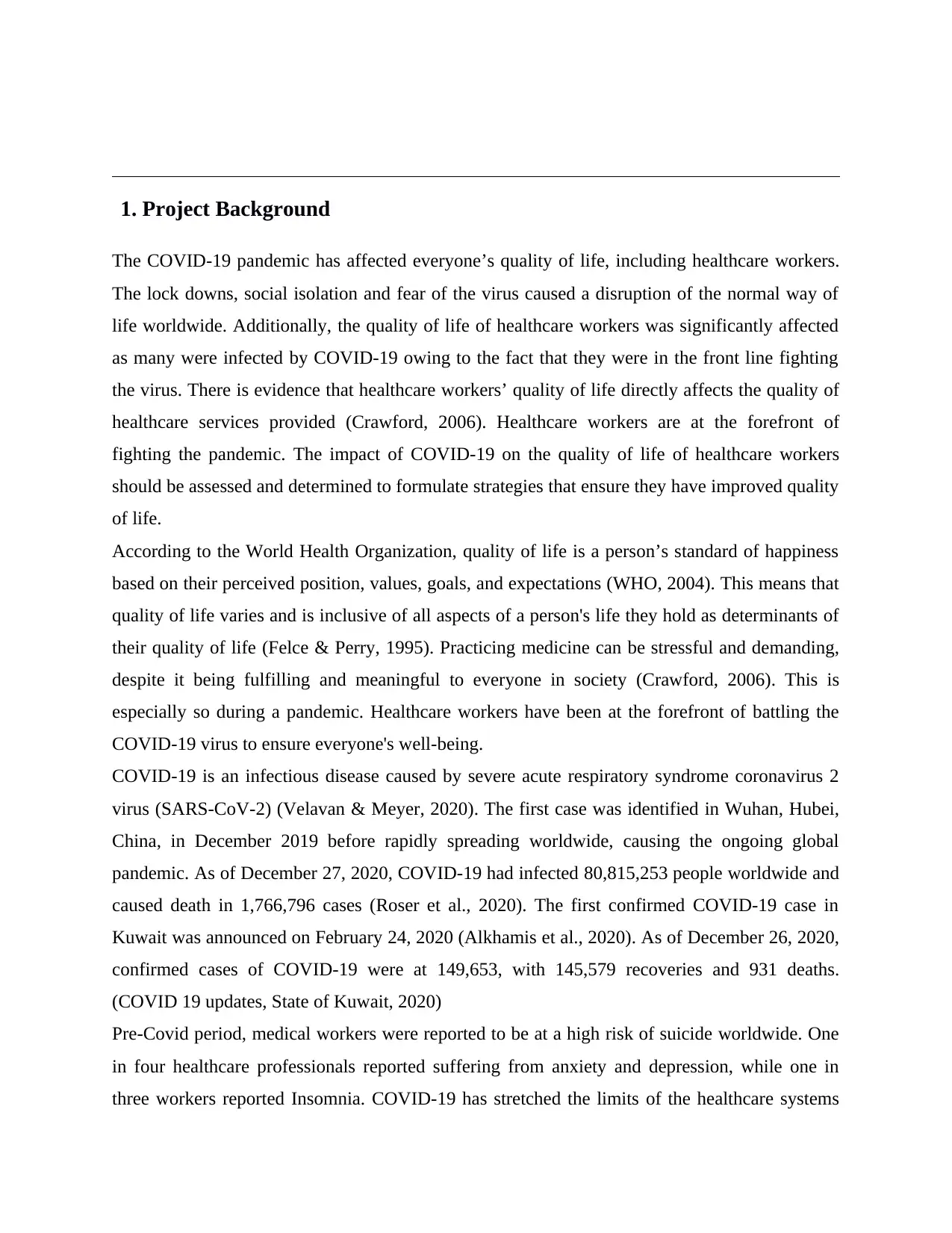
1. Project Background
The COVID-19 pandemic has affected everyone’s quality of life, including healthcare workers.
The lock downs, social isolation and fear of the virus caused a disruption of the normal way of
life worldwide. Additionally, the quality of life of healthcare workers was significantly affected
as many were infected by COVID-19 owing to the fact that they were in the front line fighting
the virus. There is evidence that healthcare workers’ quality of life directly affects the quality of
healthcare services provided (Crawford, 2006). Healthcare workers are at the forefront of
fighting the pandemic. The impact of COVID-19 on the quality of life of healthcare workers
should be assessed and determined to formulate strategies that ensure they have improved quality
of life.
According to the World Health Organization, quality of life is a person’s standard of happiness
based on their perceived position, values, goals, and expectations (WHO, 2004). This means that
quality of life varies and is inclusive of all aspects of a person's life they hold as determinants of
their quality of life (Felce & Perry, 1995). Practicing medicine can be stressful and demanding,
despite it being fulfilling and meaningful to everyone in society (Crawford, 2006). This is
especially so during a pandemic. Healthcare workers have been at the forefront of battling the
COVID-19 virus to ensure everyone's well-being.
COVID-19 is an infectious disease caused by severe acute respiratory syndrome coronavirus 2
virus (SARS-CoV-2) (Velavan & Meyer, 2020). The first case was identified in Wuhan, Hubei,
China, in December 2019 before rapidly spreading worldwide, causing the ongoing global
pandemic. As of December 27, 2020, COVID-19 had infected 80,815,253 people worldwide and
caused death in 1,766,796 cases (Roser et al., 2020). The first confirmed COVID-19 case in
Kuwait was announced on February 24, 2020 (Alkhamis et al., 2020). As of December 26, 2020,
confirmed cases of COVID-19 were at 149,653, with 145,579 recoveries and 931 deaths.
(COVID 19 updates, State of Kuwait, 2020)
Pre-Covid period, medical workers were reported to be at a high risk of suicide worldwide. One
in four healthcare professionals reported suffering from anxiety and depression, while one in
three workers reported Insomnia. COVID-19 has stretched the limits of the healthcare systems
The COVID-19 pandemic has affected everyone’s quality of life, including healthcare workers.
The lock downs, social isolation and fear of the virus caused a disruption of the normal way of
life worldwide. Additionally, the quality of life of healthcare workers was significantly affected
as many were infected by COVID-19 owing to the fact that they were in the front line fighting
the virus. There is evidence that healthcare workers’ quality of life directly affects the quality of
healthcare services provided (Crawford, 2006). Healthcare workers are at the forefront of
fighting the pandemic. The impact of COVID-19 on the quality of life of healthcare workers
should be assessed and determined to formulate strategies that ensure they have improved quality
of life.
According to the World Health Organization, quality of life is a person’s standard of happiness
based on their perceived position, values, goals, and expectations (WHO, 2004). This means that
quality of life varies and is inclusive of all aspects of a person's life they hold as determinants of
their quality of life (Felce & Perry, 1995). Practicing medicine can be stressful and demanding,
despite it being fulfilling and meaningful to everyone in society (Crawford, 2006). This is
especially so during a pandemic. Healthcare workers have been at the forefront of battling the
COVID-19 virus to ensure everyone's well-being.
COVID-19 is an infectious disease caused by severe acute respiratory syndrome coronavirus 2
virus (SARS-CoV-2) (Velavan & Meyer, 2020). The first case was identified in Wuhan, Hubei,
China, in December 2019 before rapidly spreading worldwide, causing the ongoing global
pandemic. As of December 27, 2020, COVID-19 had infected 80,815,253 people worldwide and
caused death in 1,766,796 cases (Roser et al., 2020). The first confirmed COVID-19 case in
Kuwait was announced on February 24, 2020 (Alkhamis et al., 2020). As of December 26, 2020,
confirmed cases of COVID-19 were at 149,653, with 145,579 recoveries and 931 deaths.
(COVID 19 updates, State of Kuwait, 2020)
Pre-Covid period, medical workers were reported to be at a high risk of suicide worldwide. One
in four healthcare professionals reported suffering from anxiety and depression, while one in
three workers reported Insomnia. COVID-19 has stretched the limits of the healthcare systems
Paraphrase This Document
Need a fresh take? Get an instant paraphrase of this document with our AI Paraphraser
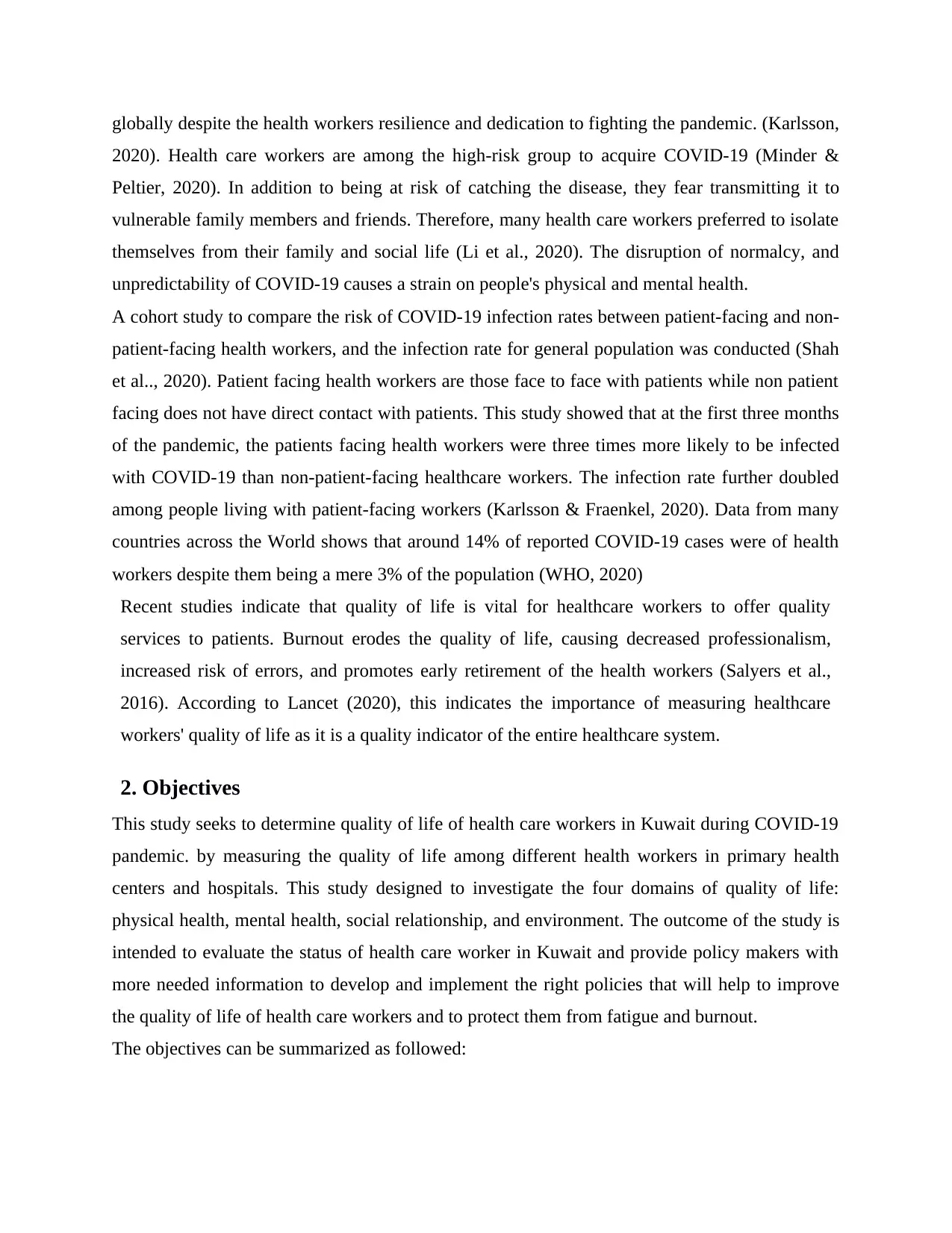
globally despite the health workers resilience and dedication to fighting the pandemic. (Karlsson,
2020). Health care workers are among the high-risk group to acquire COVID-19 (Minder &
Peltier, 2020). In addition to being at risk of catching the disease, they fear transmitting it to
vulnerable family members and friends. Therefore, many health care workers preferred to isolate
themselves from their family and social life (Li et al., 2020). The disruption of normalcy, and
unpredictability of COVID-19 causes a strain on people's physical and mental health.
A cohort study to compare the risk of COVID-19 infection rates between patient-facing and non-
patient-facing health workers, and the infection rate for general population was conducted (Shah
et al.., 2020). Patient facing health workers are those face to face with patients while non patient
facing does not have direct contact with patients. This study showed that at the first three months
of the pandemic, the patients facing health workers were three times more likely to be infected
with COVID-19 than non-patient-facing healthcare workers. The infection rate further doubled
among people living with patient-facing workers (Karlsson & Fraenkel, 2020). Data from many
countries across the World shows that around 14% of reported COVID-19 cases were of health
workers despite them being a mere 3% of the population (WHO, 2020)
Recent studies indicate that quality of life is vital for healthcare workers to offer quality
services to patients. Burnout erodes the quality of life, causing decreased professionalism,
increased risk of errors, and promotes early retirement of the health workers (Salyers et al.,
2016). According to Lancet (2020), this indicates the importance of measuring healthcare
workers' quality of life as it is a quality indicator of the entire healthcare system.
2. Objectives
This study seeks to determine quality of life of health care workers in Kuwait during COVID-19
pandemic. by measuring the quality of life among different health workers in primary health
centers and hospitals. This study designed to investigate the four domains of quality of life:
physical health, mental health, social relationship, and environment. The outcome of the study is
intended to evaluate the status of health care worker in Kuwait and provide policy makers with
more needed information to develop and implement the right policies that will help to improve
the quality of life of health care workers and to protect them from fatigue and burnout.
The objectives can be summarized as followed:
2020). Health care workers are among the high-risk group to acquire COVID-19 (Minder &
Peltier, 2020). In addition to being at risk of catching the disease, they fear transmitting it to
vulnerable family members and friends. Therefore, many health care workers preferred to isolate
themselves from their family and social life (Li et al., 2020). The disruption of normalcy, and
unpredictability of COVID-19 causes a strain on people's physical and mental health.
A cohort study to compare the risk of COVID-19 infection rates between patient-facing and non-
patient-facing health workers, and the infection rate for general population was conducted (Shah
et al.., 2020). Patient facing health workers are those face to face with patients while non patient
facing does not have direct contact with patients. This study showed that at the first three months
of the pandemic, the patients facing health workers were three times more likely to be infected
with COVID-19 than non-patient-facing healthcare workers. The infection rate further doubled
among people living with patient-facing workers (Karlsson & Fraenkel, 2020). Data from many
countries across the World shows that around 14% of reported COVID-19 cases were of health
workers despite them being a mere 3% of the population (WHO, 2020)
Recent studies indicate that quality of life is vital for healthcare workers to offer quality
services to patients. Burnout erodes the quality of life, causing decreased professionalism,
increased risk of errors, and promotes early retirement of the health workers (Salyers et al.,
2016). According to Lancet (2020), this indicates the importance of measuring healthcare
workers' quality of life as it is a quality indicator of the entire healthcare system.
2. Objectives
This study seeks to determine quality of life of health care workers in Kuwait during COVID-19
pandemic. by measuring the quality of life among different health workers in primary health
centers and hospitals. This study designed to investigate the four domains of quality of life:
physical health, mental health, social relationship, and environment. The outcome of the study is
intended to evaluate the status of health care worker in Kuwait and provide policy makers with
more needed information to develop and implement the right policies that will help to improve
the quality of life of health care workers and to protect them from fatigue and burnout.
The objectives can be summarized as followed:
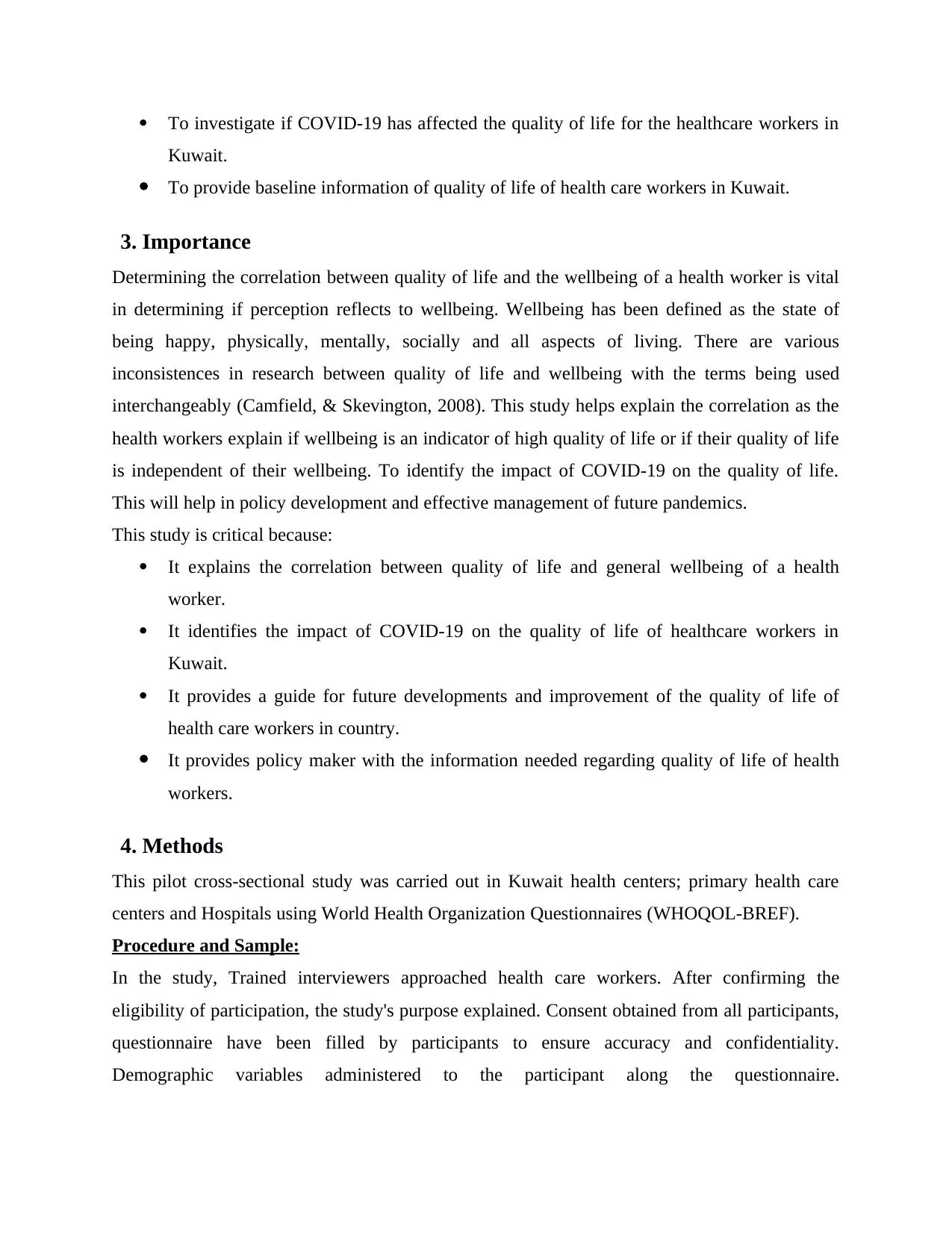
To investigate if COVID-19 has affected the quality of life for the healthcare workers in
Kuwait.
To provide baseline information of quality of life of health care workers in Kuwait.
3. Importance
Determining the correlation between quality of life and the wellbeing of a health worker is vital
in determining if perception reflects to wellbeing. Wellbeing has been defined as the state of
being happy, physically, mentally, socially and all aspects of living. There are various
inconsistences in research between quality of life and wellbeing with the terms being used
interchangeably (Camfield, & Skevington, 2008). This study helps explain the correlation as the
health workers explain if wellbeing is an indicator of high quality of life or if their quality of life
is independent of their wellbeing. To identify the impact of COVID-19 on the quality of life.
This will help in policy development and effective management of future pandemics.
This study is critical because:
It explains the correlation between quality of life and general wellbeing of a health
worker.
It identifies the impact of COVID-19 on the quality of life of healthcare workers in
Kuwait.
It provides a guide for future developments and improvement of the quality of life of
health care workers in country.
It provides policy maker with the information needed regarding quality of life of health
workers.
4. Methods
This pilot cross-sectional study was carried out in Kuwait health centers; primary health care
centers and Hospitals using World Health Organization Questionnaires (WHOQOL-BREF).
Procedure and Sample:
In the study, Trained interviewers approached health care workers. After confirming the
eligibility of participation, the study's purpose explained. Consent obtained from all participants,
questionnaire have been filled by participants to ensure accuracy and confidentiality.
Demographic variables administered to the participant along the questionnaire.
Kuwait.
To provide baseline information of quality of life of health care workers in Kuwait.
3. Importance
Determining the correlation between quality of life and the wellbeing of a health worker is vital
in determining if perception reflects to wellbeing. Wellbeing has been defined as the state of
being happy, physically, mentally, socially and all aspects of living. There are various
inconsistences in research between quality of life and wellbeing with the terms being used
interchangeably (Camfield, & Skevington, 2008). This study helps explain the correlation as the
health workers explain if wellbeing is an indicator of high quality of life or if their quality of life
is independent of their wellbeing. To identify the impact of COVID-19 on the quality of life.
This will help in policy development and effective management of future pandemics.
This study is critical because:
It explains the correlation between quality of life and general wellbeing of a health
worker.
It identifies the impact of COVID-19 on the quality of life of healthcare workers in
Kuwait.
It provides a guide for future developments and improvement of the quality of life of
health care workers in country.
It provides policy maker with the information needed regarding quality of life of health
workers.
4. Methods
This pilot cross-sectional study was carried out in Kuwait health centers; primary health care
centers and Hospitals using World Health Organization Questionnaires (WHOQOL-BREF).
Procedure and Sample:
In the study, Trained interviewers approached health care workers. After confirming the
eligibility of participation, the study's purpose explained. Consent obtained from all participants,
questionnaire have been filled by participants to ensure accuracy and confidentiality.
Demographic variables administered to the participant along the questionnaire.
⊘ This is a preview!⊘
Do you want full access?
Subscribe today to unlock all pages.

Trusted by 1+ million students worldwide
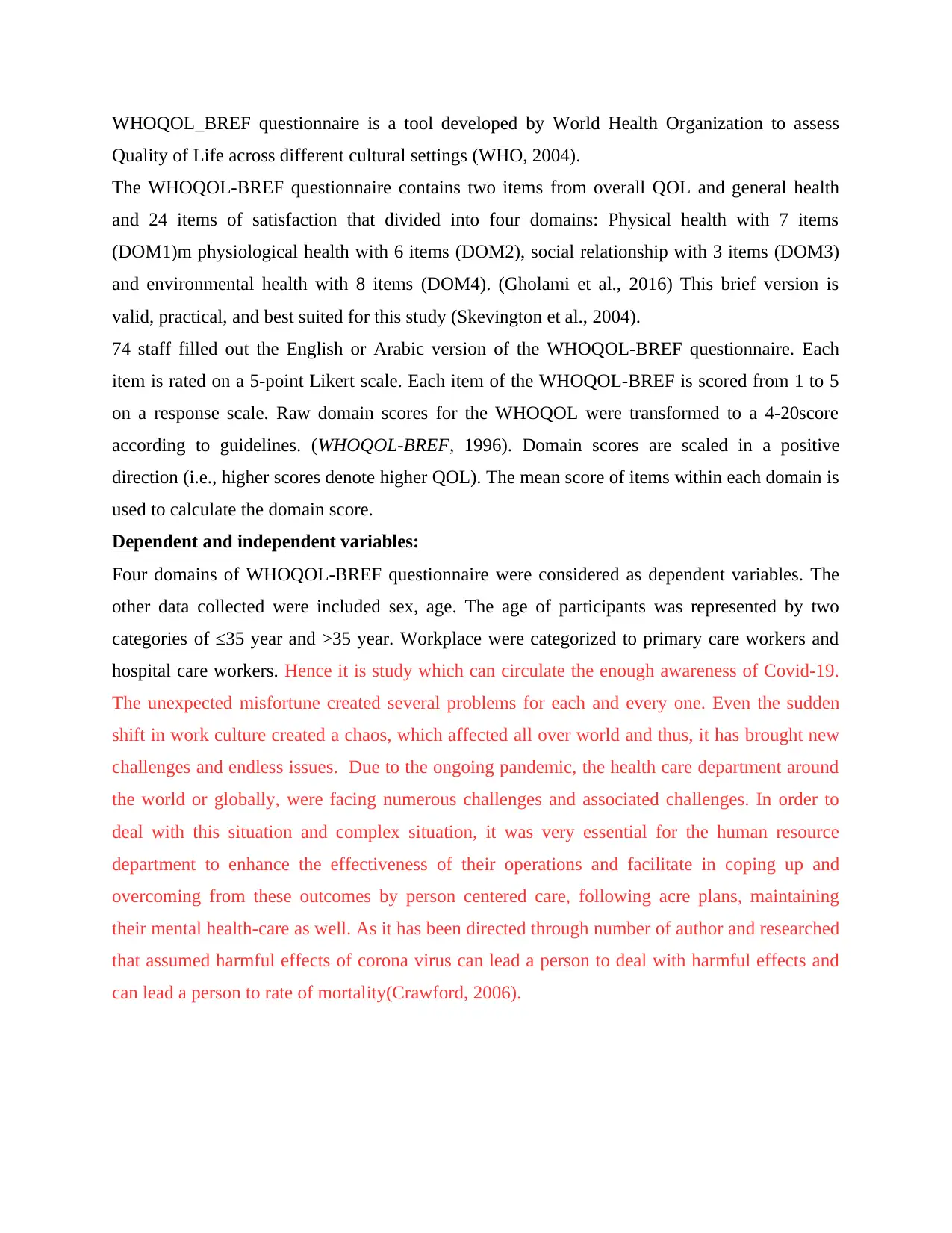
WHOQOL_BREF questionnaire is a tool developed by World Health Organization to assess
Quality of Life across different cultural settings (WHO, 2004).
The WHOQOL-BREF questionnaire contains two items from overall QOL and general health
and 24 items of satisfaction that divided into four domains: Physical health with 7 items
(DOM1)m physiological health with 6 items (DOM2), social relationship with 3 items (DOM3)
and environmental health with 8 items (DOM4). (Gholami et al., 2016) This brief version is
valid, practical, and best suited for this study (Skevington et al., 2004).
74 staff filled out the English or Arabic version of the WHOQOL-BREF questionnaire. Each
item is rated on a 5-point Likert scale. Each item of the WHOQOL-BREF is scored from 1 to 5
on a response scale. Raw domain scores for the WHOQOL were transformed to a 4-20score
according to guidelines. (WHOQOL-BREF, 1996). Domain scores are scaled in a positive
direction (i.e., higher scores denote higher QOL). The mean score of items within each domain is
used to calculate the domain score.
Dependent and independent variables:
Four domains of WHOQOL-BREF questionnaire were considered as dependent variables. The
other data collected were included sex, age. The age of participants was represented by two
categories of ≤35 year and >35 year. Workplace were categorized to primary care workers and
hospital care workers. Hence it is study which can circulate the enough awareness of Covid-19.
The unexpected misfortune created several problems for each and every one. Even the sudden
shift in work culture created a chaos, which affected all over world and thus, it has brought new
challenges and endless issues. Due to the ongoing pandemic, the health care department around
the world or globally, were facing numerous challenges and associated challenges. In order to
deal with this situation and complex situation, it was very essential for the human resource
department to enhance the effectiveness of their operations and facilitate in coping up and
overcoming from these outcomes by person centered care, following acre plans, maintaining
their mental health-care as well. As it has been directed through number of author and researched
that assumed harmful effects of corona virus can lead a person to deal with harmful effects and
can lead a person to rate of mortality(Crawford, 2006).
Quality of Life across different cultural settings (WHO, 2004).
The WHOQOL-BREF questionnaire contains two items from overall QOL and general health
and 24 items of satisfaction that divided into four domains: Physical health with 7 items
(DOM1)m physiological health with 6 items (DOM2), social relationship with 3 items (DOM3)
and environmental health with 8 items (DOM4). (Gholami et al., 2016) This brief version is
valid, practical, and best suited for this study (Skevington et al., 2004).
74 staff filled out the English or Arabic version of the WHOQOL-BREF questionnaire. Each
item is rated on a 5-point Likert scale. Each item of the WHOQOL-BREF is scored from 1 to 5
on a response scale. Raw domain scores for the WHOQOL were transformed to a 4-20score
according to guidelines. (WHOQOL-BREF, 1996). Domain scores are scaled in a positive
direction (i.e., higher scores denote higher QOL). The mean score of items within each domain is
used to calculate the domain score.
Dependent and independent variables:
Four domains of WHOQOL-BREF questionnaire were considered as dependent variables. The
other data collected were included sex, age. The age of participants was represented by two
categories of ≤35 year and >35 year. Workplace were categorized to primary care workers and
hospital care workers. Hence it is study which can circulate the enough awareness of Covid-19.
The unexpected misfortune created several problems for each and every one. Even the sudden
shift in work culture created a chaos, which affected all over world and thus, it has brought new
challenges and endless issues. Due to the ongoing pandemic, the health care department around
the world or globally, were facing numerous challenges and associated challenges. In order to
deal with this situation and complex situation, it was very essential for the human resource
department to enhance the effectiveness of their operations and facilitate in coping up and
overcoming from these outcomes by person centered care, following acre plans, maintaining
their mental health-care as well. As it has been directed through number of author and researched
that assumed harmful effects of corona virus can lead a person to deal with harmful effects and
can lead a person to rate of mortality(Crawford, 2006).
Paraphrase This Document
Need a fresh take? Get an instant paraphrase of this document with our AI Paraphraser
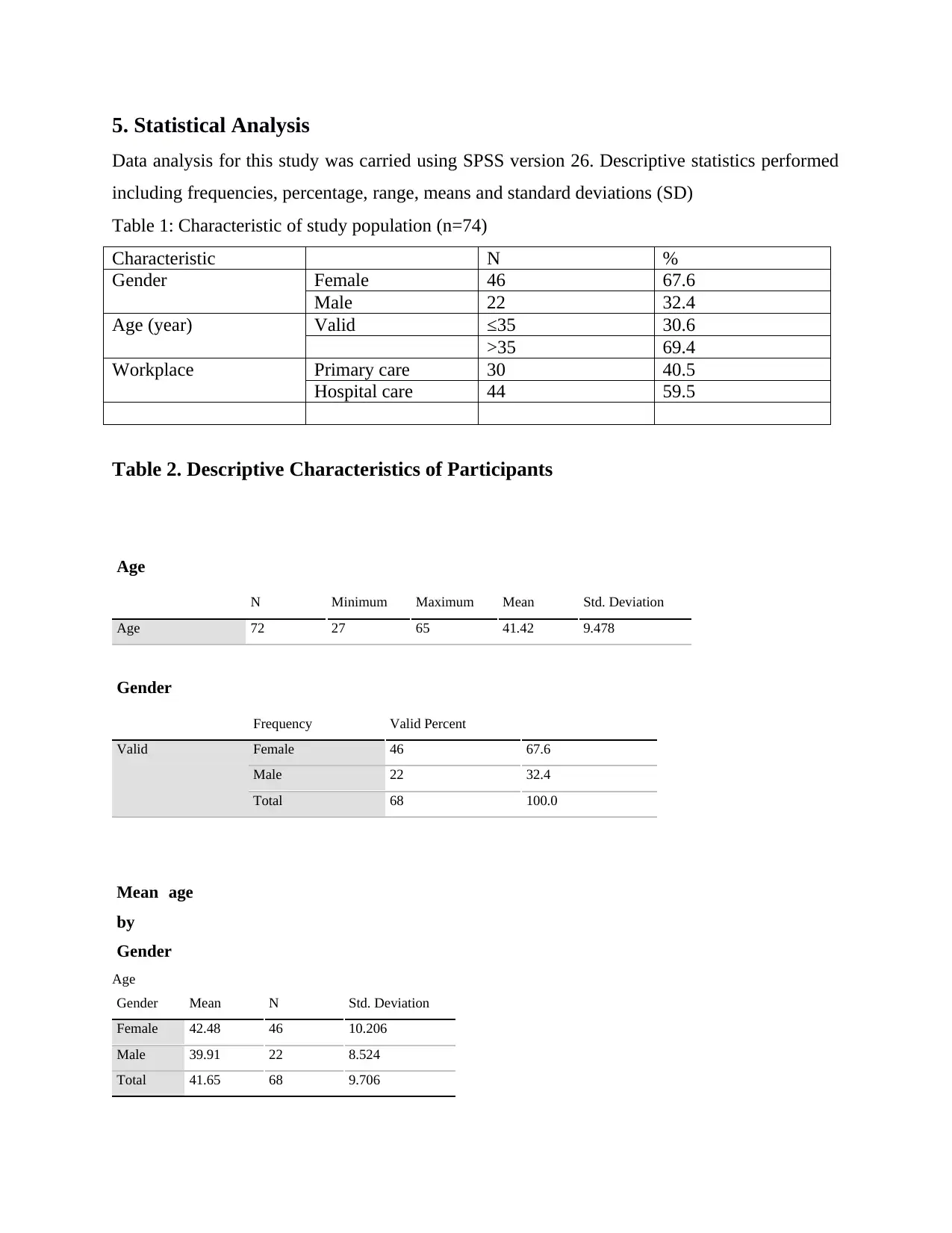
5. Statistical Analysis
Data analysis for this study was carried using SPSS version 26. Descriptive statistics performed
including frequencies, percentage, range, means and standard deviations (SD)
Table 1: Characteristic of study population (n=74)
Characteristic N %
Gender Female 46 67.6
Male 22 32.4
Age (year) Valid ≤35 30.6
>35 69.4
Workplace Primary care 30 40.5
Hospital care 44 59.5
Table 2. Descriptive Characteristics of Participants
Age
N Minimum Maximum Mean Std. Deviation
Age 72 27 65 41.42 9.478
Gender
Frequency Valid Percent
Valid Female 46 67.6
Male 22 32.4
Total 68 100.0
Mean age
by
Gender
Age
Gender Mean N Std. Deviation
Female 42.48 46 10.206
Male 39.91 22 8.524
Total 41.65 68 9.706
Data analysis for this study was carried using SPSS version 26. Descriptive statistics performed
including frequencies, percentage, range, means and standard deviations (SD)
Table 1: Characteristic of study population (n=74)
Characteristic N %
Gender Female 46 67.6
Male 22 32.4
Age (year) Valid ≤35 30.6
>35 69.4
Workplace Primary care 30 40.5
Hospital care 44 59.5
Table 2. Descriptive Characteristics of Participants
Age
N Minimum Maximum Mean Std. Deviation
Age 72 27 65 41.42 9.478
Gender
Frequency Valid Percent
Valid Female 46 67.6
Male 22 32.4
Total 68 100.0
Mean age
by
Gender
Age
Gender Mean N Std. Deviation
Female 42.48 46 10.206
Male 39.91 22 8.524
Total 41.65 68 9.706
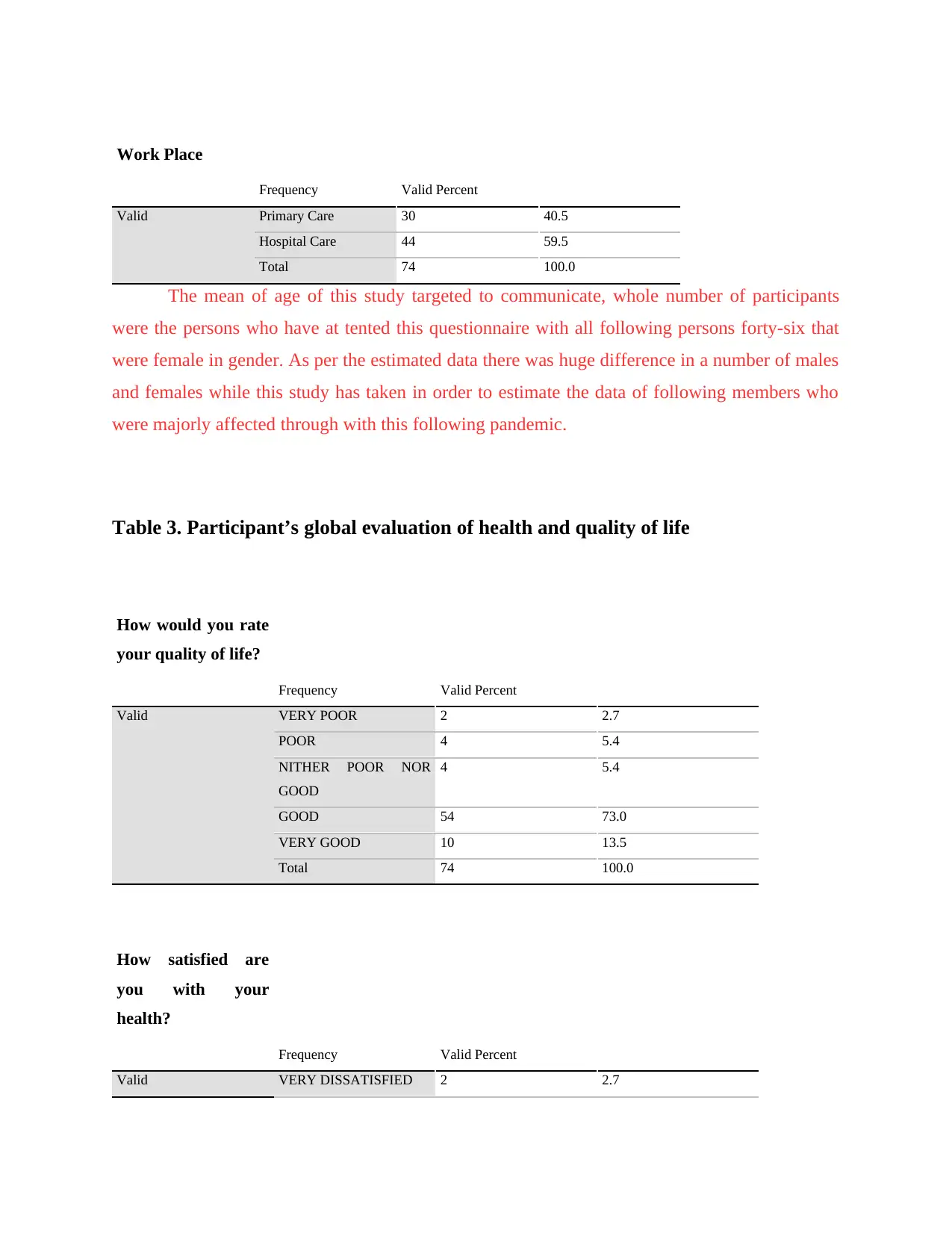
Work Place
Frequency Valid Percent
Valid Primary Care 30 40.5
Hospital Care 44 59.5
Total 74 100.0
The mean of age of this study targeted to communicate, whole number of participants
were the persons who have at tented this questionnaire with all following persons forty-six that
were female in gender. As per the estimated data there was huge difference in a number of males
and females while this study has taken in order to estimate the data of following members who
were majorly affected through with this following pandemic.
Table 3. Participant’s global evaluation of health and quality of life
How would you rate
your quality of life?
Frequency Valid Percent
Valid VERY POOR 2 2.7
POOR 4 5.4
NITHER POOR NOR
GOOD
4 5.4
GOOD 54 73.0
VERY GOOD 10 13.5
Total 74 100.0
How satisfied are
you with your
health?
Frequency Valid Percent
Valid VERY DISSATISFIED 2 2.7
Frequency Valid Percent
Valid Primary Care 30 40.5
Hospital Care 44 59.5
Total 74 100.0
The mean of age of this study targeted to communicate, whole number of participants
were the persons who have at tented this questionnaire with all following persons forty-six that
were female in gender. As per the estimated data there was huge difference in a number of males
and females while this study has taken in order to estimate the data of following members who
were majorly affected through with this following pandemic.
Table 3. Participant’s global evaluation of health and quality of life
How would you rate
your quality of life?
Frequency Valid Percent
Valid VERY POOR 2 2.7
POOR 4 5.4
NITHER POOR NOR
GOOD
4 5.4
GOOD 54 73.0
VERY GOOD 10 13.5
Total 74 100.0
How satisfied are
you with your
health?
Frequency Valid Percent
Valid VERY DISSATISFIED 2 2.7
⊘ This is a preview!⊘
Do you want full access?
Subscribe today to unlock all pages.

Trusted by 1+ million students worldwide
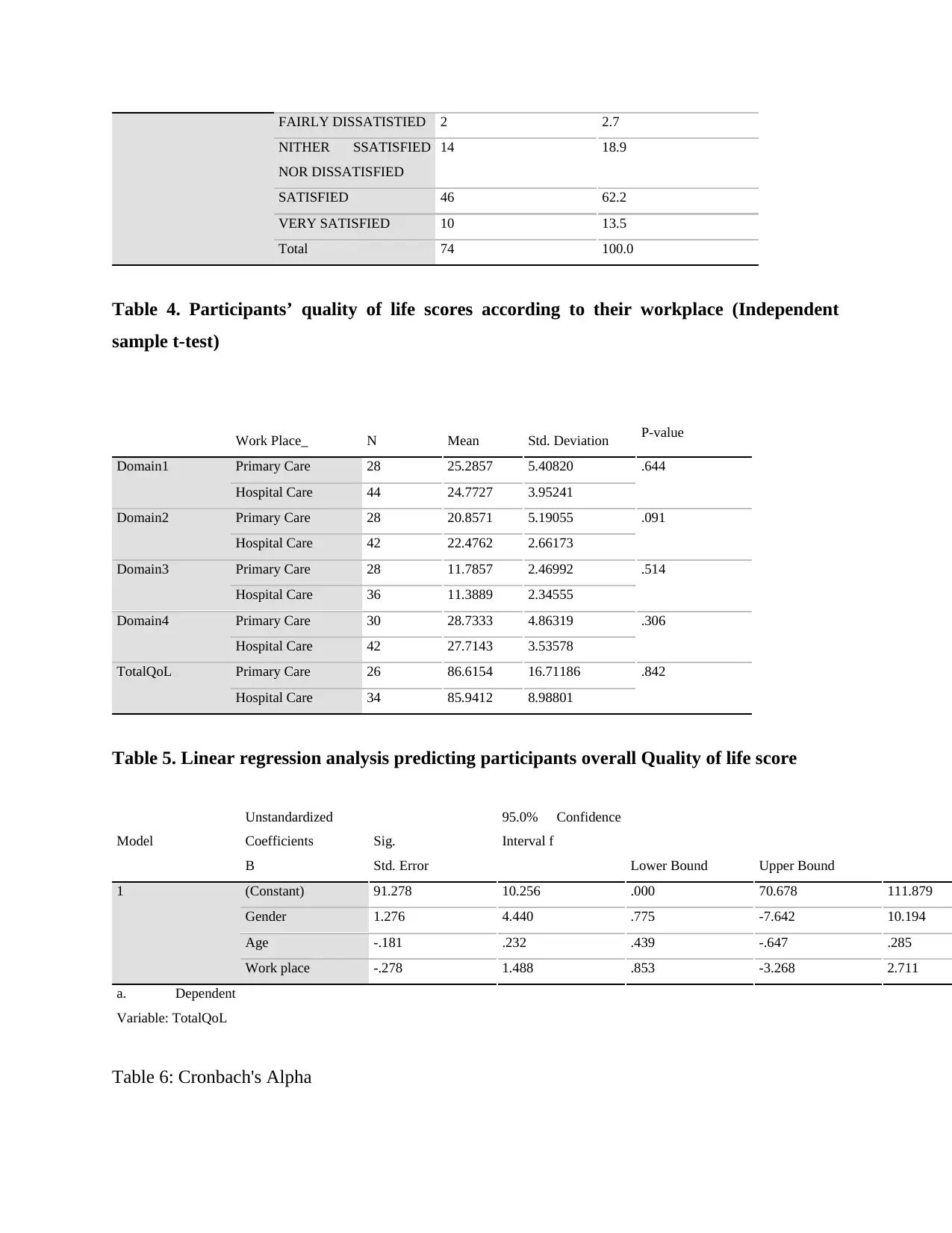
FAIRLY DISSATISTIED 2 2.7
NITHER SSATISFIED
NOR DISSATISFIED
14 18.9
SATISFIED 46 62.2
VERY SATISFIED 10 13.5
Total 74 100.0
Table 4. Participants’ quality of life scores according to their workplace (Independent
sample t-test)
Work Place_ N Mean Std. Deviation P-value
Domain1 Primary Care 28 25.2857 5.40820 .644
Hospital Care 44 24.7727 3.95241
Domain2 Primary Care 28 20.8571 5.19055 .091
Hospital Care 42 22.4762 2.66173
Domain3 Primary Care 28 11.7857 2.46992 .514
Hospital Care 36 11.3889 2.34555
Domain4 Primary Care 30 28.7333 4.86319 .306
Hospital Care 42 27.7143 3.53578
TotalQoL Primary Care 26 86.6154 16.71186 .842
Hospital Care 34 85.9412 8.98801
Table 5. Linear regression analysis predicting participants overall Quality of life score
Model
Unstandardized
Coefficients Sig.
95.0% Confidence
Interval f
B Std. Error Lower Bound Upper Bound
1 (Constant) 91.278 10.256 .000 70.678 111.879
Gender 1.276 4.440 .775 -7.642 10.194
Age -.181 .232 .439 -.647 .285
Work place -.278 1.488 .853 -3.268 2.711
a. Dependent
Variable: TotalQoL
Table 6: Cronbach's Alpha
NITHER SSATISFIED
NOR DISSATISFIED
14 18.9
SATISFIED 46 62.2
VERY SATISFIED 10 13.5
Total 74 100.0
Table 4. Participants’ quality of life scores according to their workplace (Independent
sample t-test)
Work Place_ N Mean Std. Deviation P-value
Domain1 Primary Care 28 25.2857 5.40820 .644
Hospital Care 44 24.7727 3.95241
Domain2 Primary Care 28 20.8571 5.19055 .091
Hospital Care 42 22.4762 2.66173
Domain3 Primary Care 28 11.7857 2.46992 .514
Hospital Care 36 11.3889 2.34555
Domain4 Primary Care 30 28.7333 4.86319 .306
Hospital Care 42 27.7143 3.53578
TotalQoL Primary Care 26 86.6154 16.71186 .842
Hospital Care 34 85.9412 8.98801
Table 5. Linear regression analysis predicting participants overall Quality of life score
Model
Unstandardized
Coefficients Sig.
95.0% Confidence
Interval f
B Std. Error Lower Bound Upper Bound
1 (Constant) 91.278 10.256 .000 70.678 111.879
Gender 1.276 4.440 .775 -7.642 10.194
Age -.181 .232 .439 -.647 .285
Work place -.278 1.488 .853 -3.268 2.711
a. Dependent
Variable: TotalQoL
Table 6: Cronbach's Alpha
Paraphrase This Document
Need a fresh take? Get an instant paraphrase of this document with our AI Paraphraser
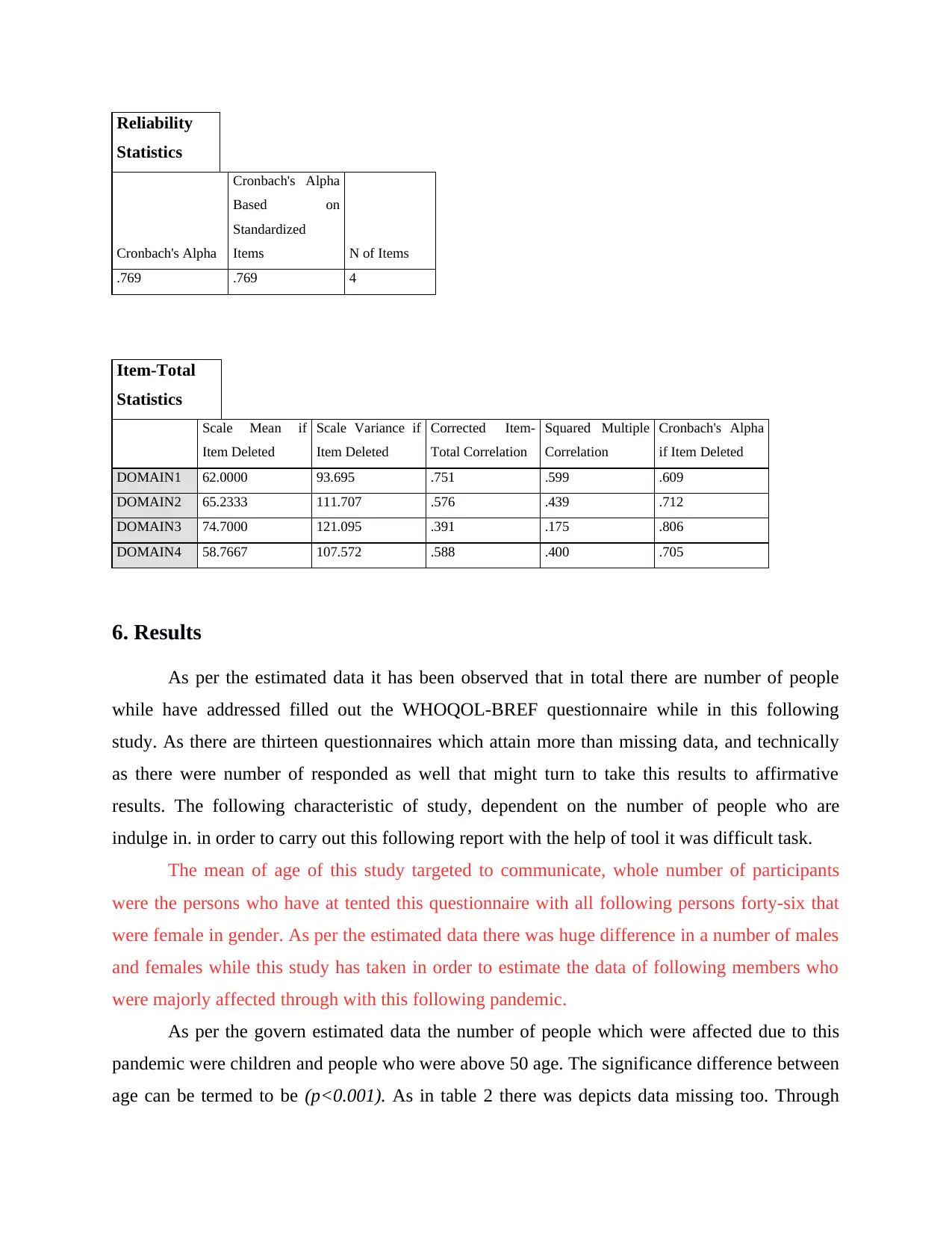
Reliability
Statistics
Cronbach's Alpha
Cronbach's Alpha
Based on
Standardized
Items N of Items
.769 .769 4
Item-Total
Statistics
Scale Mean if
Item Deleted
Scale Variance if
Item Deleted
Corrected Item-
Total Correlation
Squared Multiple
Correlation
Cronbach's Alpha
if Item Deleted
DOMAIN1 62.0000 93.695 .751 .599 .609
DOMAIN2 65.2333 111.707 .576 .439 .712
DOMAIN3 74.7000 121.095 .391 .175 .806
DOMAIN4 58.7667 107.572 .588 .400 .705
6. Results
As per the estimated data it has been observed that in total there are number of people
while have addressed filled out the WHOQOL-BREF questionnaire while in this following
study. As there are thirteen questionnaires which attain more than missing data, and technically
as there were number of responded as well that might turn to take this results to affirmative
results. The following characteristic of study, dependent on the number of people who are
indulge in. in order to carry out this following report with the help of tool it was difficult task.
The mean of age of this study targeted to communicate, whole number of participants
were the persons who have at tented this questionnaire with all following persons forty-six that
were female in gender. As per the estimated data there was huge difference in a number of males
and females while this study has taken in order to estimate the data of following members who
were majorly affected through with this following pandemic.
As per the govern estimated data the number of people which were affected due to this
pandemic were children and people who were above 50 age. The significance difference between
age can be termed to be (p<0.001). As in table 2 there was depicts data missing too. Through
Statistics
Cronbach's Alpha
Cronbach's Alpha
Based on
Standardized
Items N of Items
.769 .769 4
Item-Total
Statistics
Scale Mean if
Item Deleted
Scale Variance if
Item Deleted
Corrected Item-
Total Correlation
Squared Multiple
Correlation
Cronbach's Alpha
if Item Deleted
DOMAIN1 62.0000 93.695 .751 .599 .609
DOMAIN2 65.2333 111.707 .576 .439 .712
DOMAIN3 74.7000 121.095 .391 .175 .806
DOMAIN4 58.7667 107.572 .588 .400 .705
6. Results
As per the estimated data it has been observed that in total there are number of people
while have addressed filled out the WHOQOL-BREF questionnaire while in this following
study. As there are thirteen questionnaires which attain more than missing data, and technically
as there were number of responded as well that might turn to take this results to affirmative
results. The following characteristic of study, dependent on the number of people who are
indulge in. in order to carry out this following report with the help of tool it was difficult task.
The mean of age of this study targeted to communicate, whole number of participants
were the persons who have at tented this questionnaire with all following persons forty-six that
were female in gender. As per the estimated data there was huge difference in a number of males
and females while this study has taken in order to estimate the data of following members who
were majorly affected through with this following pandemic.
As per the govern estimated data the number of people which were affected due to this
pandemic were children and people who were above 50 age. The significance difference between
age can be termed to be (p<0.001). As in table 2 there was depicts data missing too. Through
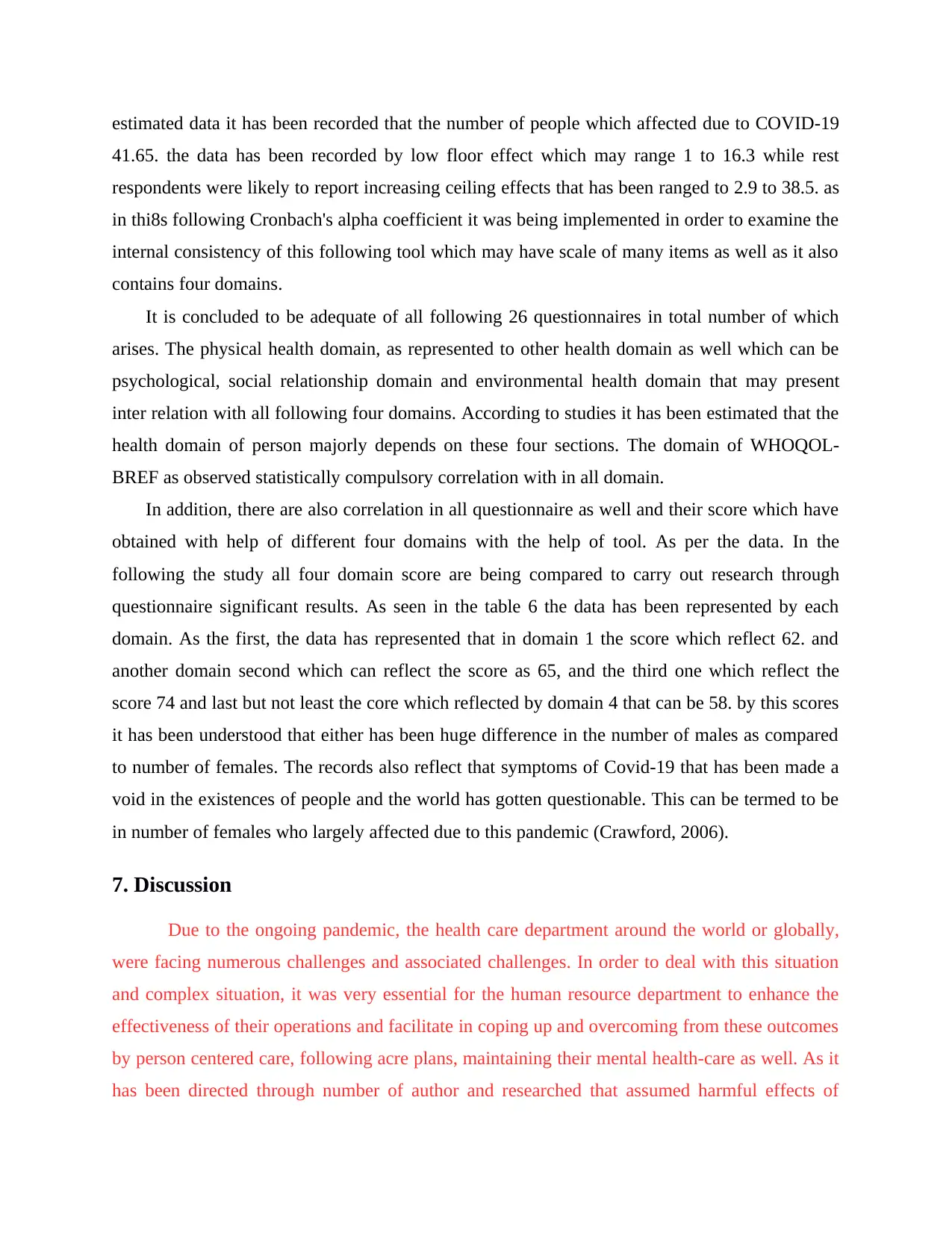
estimated data it has been recorded that the number of people which affected due to COVID-19
41.65. the data has been recorded by low floor effect which may range 1 to 16.3 while rest
respondents were likely to report increasing ceiling effects that has been ranged to 2.9 to 38.5. as
in thi8s following Cronbach's alpha coefficient it was being implemented in order to examine the
internal consistency of this following tool which may have scale of many items as well as it also
contains four domains.
It is concluded to be adequate of all following 26 questionnaires in total number of which
arises. The physical health domain, as represented to other health domain as well which can be
psychological, social relationship domain and environmental health domain that may present
inter relation with all following four domains. According to studies it has been estimated that the
health domain of person majorly depends on these four sections. The domain of WHOQOL-
BREF as observed statistically compulsory correlation with in all domain.
In addition, there are also correlation in all questionnaire as well and their score which have
obtained with help of different four domains with the help of tool. As per the data. In the
following the study all four domain score are being compared to carry out research through
questionnaire significant results. As seen in the table 6 the data has been represented by each
domain. As the first, the data has represented that in domain 1 the score which reflect 62. and
another domain second which can reflect the score as 65, and the third one which reflect the
score 74 and last but not least the core which reflected by domain 4 that can be 58. by this scores
it has been understood that either has been huge difference in the number of males as compared
to number of females. The records also reflect that symptoms of Covid-19 that has been made a
void in the existences of people and the world has gotten questionable. This can be termed to be
in number of females who largely affected due to this pandemic (Crawford, 2006).
7. Discussion
Due to the ongoing pandemic, the health care department around the world or globally,
were facing numerous challenges and associated challenges. In order to deal with this situation
and complex situation, it was very essential for the human resource department to enhance the
effectiveness of their operations and facilitate in coping up and overcoming from these outcomes
by person centered care, following acre plans, maintaining their mental health-care as well. As it
has been directed through number of author and researched that assumed harmful effects of
41.65. the data has been recorded by low floor effect which may range 1 to 16.3 while rest
respondents were likely to report increasing ceiling effects that has been ranged to 2.9 to 38.5. as
in thi8s following Cronbach's alpha coefficient it was being implemented in order to examine the
internal consistency of this following tool which may have scale of many items as well as it also
contains four domains.
It is concluded to be adequate of all following 26 questionnaires in total number of which
arises. The physical health domain, as represented to other health domain as well which can be
psychological, social relationship domain and environmental health domain that may present
inter relation with all following four domains. According to studies it has been estimated that the
health domain of person majorly depends on these four sections. The domain of WHOQOL-
BREF as observed statistically compulsory correlation with in all domain.
In addition, there are also correlation in all questionnaire as well and their score which have
obtained with help of different four domains with the help of tool. As per the data. In the
following the study all four domain score are being compared to carry out research through
questionnaire significant results. As seen in the table 6 the data has been represented by each
domain. As the first, the data has represented that in domain 1 the score which reflect 62. and
another domain second which can reflect the score as 65, and the third one which reflect the
score 74 and last but not least the core which reflected by domain 4 that can be 58. by this scores
it has been understood that either has been huge difference in the number of males as compared
to number of females. The records also reflect that symptoms of Covid-19 that has been made a
void in the existences of people and the world has gotten questionable. This can be termed to be
in number of females who largely affected due to this pandemic (Crawford, 2006).
7. Discussion
Due to the ongoing pandemic, the health care department around the world or globally,
were facing numerous challenges and associated challenges. In order to deal with this situation
and complex situation, it was very essential for the human resource department to enhance the
effectiveness of their operations and facilitate in coping up and overcoming from these outcomes
by person centered care, following acre plans, maintaining their mental health-care as well. As it
has been directed through number of author and researched that assumed harmful effects of
⊘ This is a preview!⊘
Do you want full access?
Subscribe today to unlock all pages.

Trusted by 1+ million students worldwide
1 out of 17
Related Documents
Your All-in-One AI-Powered Toolkit for Academic Success.
+13062052269
info@desklib.com
Available 24*7 on WhatsApp / Email
![[object Object]](/_next/static/media/star-bottom.7253800d.svg)
Unlock your academic potential
Copyright © 2020–2025 A2Z Services. All Rights Reserved. Developed and managed by ZUCOL.




